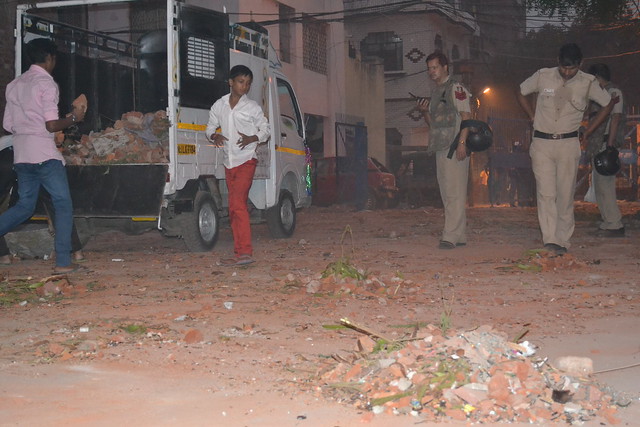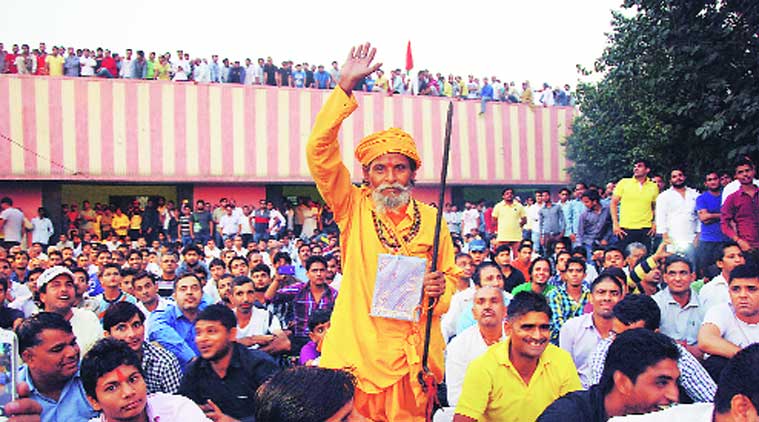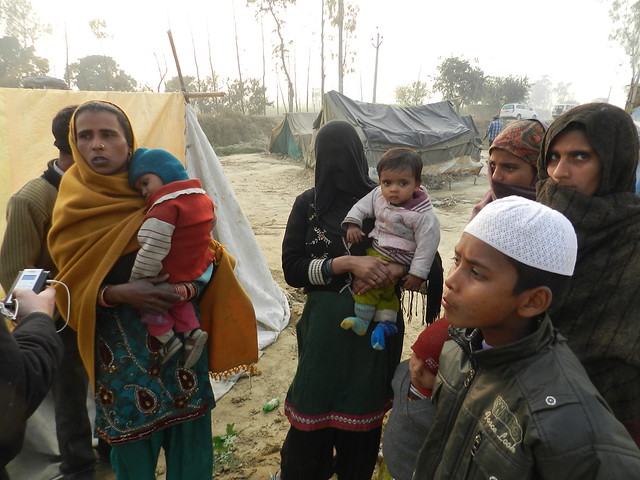By M Reyaz, TwoCircles.net,
What had started from Meerut to Moradabad has come to play out in Delhi neighbourhoods. From Trilokpuri to Bawana to Okhla, a unique and dangerous kind of social engineering is at play. Drum up a riot, no casualty only some people injured but you have the desired impact – communal polarization.
With the saffron party now in power at the Centre and Delhi set for assembly elections in days to come, will these kind of incidents increase?

Trilokpuri after communal riot (file photo)
The Muzaffarnagar riots of September 2013 certainly helped the Saffron party in Hindu votes consolidation that won them more seats than ever in Uttar Pradesh, particularly in Western UP. The saffron front had not been able to deliver similar result even at the height of the Ram Janm Bhoomi movement.
The ball has once again started rolling for the Delhi Assembly election after the recent nod by the Union Cabinet to dissolve the assembly. This will end months of deadlock that began after Arvind Kejriwal of the Aam Aadmi Party (AAP) had resigned dramatically after only 49 days in office in February 2014.
Though no formal announcement has been made yet, the elections are expected to be held in the month of February. The preparations for the elections, however, appear to have started weeks ahead as the national capital is witnessing increasing attempts at communal polarisation. Bawana, Trilokpuri, Babarpur and Madanpur Khadar in Okhla constituency are just the manifestations of the goings on at the ground.
A dead pig was found inside a mosque in Madanpur Khadar area in Oklha constituency on the morning of November 5, Wednesday when the Imam of the local mosque went for the morning prayers. The Imam and the residents tactfully ensured that the news did not spread immediately to the locality and averted a possible communal flare up. Local Muslims and Hindus presented an example of harmony and restrain as a peace committee was immediately formed and the issue resolved.
Tension had erupted in Noor-e-Ilahi area of northeast Delhi’s Babarpur constituency on November 10, Monday, when parts of a cow’s carcass were found at a market place.
Two months ago, on the occasion of Eid-ul-Adha (few days after Dushera) posters were put up by Hindu Krnati Sena in Bawana in North-West Delhi urging the youth to ‘take oath’ to prevent cow slaughter and that “truthful Hindus should come forward” to “raise voice against the constant threat to Hindu religion.” Communal tension was simmering, but prompt action and large number of deployment of force thwarted any attempt at disturbing the peace in the locality.
Weeks later, Trliokpuri in East Delhi saw another communal flare up during Diwali that continued for two days and could be controlled only after imposing curfew. It has been alleged that the Delhi Police remained mute spectator for over two days at least as communal pitch rose in Trilokpuri area leading to stone pelting and firing, injuring several. The Police, however, later swung into action and arrested several people.

A mahapanchayat was held in Bawana against taziya even after Muslims had agreed to keep to their streets. (Source: Express photo by Gajendra Yadav)
The latest example was the communal pitch that was raised in Bawana once again on the occasion of Muharram. A mahapanchayat of Delhi villages was called 15 days ago opposing Muharram procession. Interestingly, as per the media reports, the Bawana resettlement colony residents had alleged that such a large number of people were allowed to gather, chant provoking and communal slogans and make statements, even when they had no written permission from the local administration.
The mahapanchayat was called by Bhagat Singh Kranti Sena to put up a “united Hindu front” opposing “nuisance created in the name of Muharram procession.” Posters were put up in the locality urging people to assemble in large number against open show of arms, “illegal show of strength” and “nuisance” created in the name of Muharram. Rabid communalism was on display at the Bawana mahapanchayat, very similar to a mahapanchayat last year that triggered the Muzaffarnagar-Shamli riots.
Besides attempts at polarisation of votes at these three places, there is another common and significant thread binding them: all these places are suburbs in the national capital, where poor labourers and working class migrant labourers, often shifted / displaced / rehabilitated from various slums live. The Muslim pockets in Bawana are Jhuggi Jhompri (JJ) colonies, whereas JJ colonies in Madanpur Khadar came up after people from slums from where now electronic market at the Nehru Place stands, were shifted few decades ago.
Like Muzaffarnagar-Shamli, the Hindu population comprised Jats, an OBC caste, in Bawana, while both in Trilokpuri and in Madanpur Khadar majority of population comprised Dalits. Bawana otherwise is an SC reserved seat, where the BJP candidate Gugan Singh had won the 2013 Assembly election. Asif Mohamamd Khan had won the Okhla seat. He had shifted to Congress few months before the election. In Trilokpuri, it was the debutant Aam Aadmi Party (AAP) candidate who had won.
Incidentally, during the Lok Sabha 2014 polls, BJP’s debutant Mahesh Giri – under the apparent ‘Modi wave – had defeated sitting Congress MP Sandeep Dikshit from East Delhi. Both Madanpur Khadar and Trilokpuri are part of the same Lok Sabha constituency.
Babarpur constituency, which roughly has 63:37 Hindus-Muslims population, is a BJP stronghold for last four consecutive elections when Naresh Gaur won it for the saffron party. Congress’ Zakir Khan was second with nearly 26% of votes while AAP’s Gopal Rai managed above 22% votes.
The Congress party is already at its lowest ebb and if any other party which stands to lose from such polarisation in Delhi in the coming election, it will be the Aam Aadmi Party. Perhaps, AAP too realized the gravity of the situation as the party directed its former MLAs and Vidhan Sabha convenors in all 70 assembly segments to “immediately take concrete steps to foil such evil designs in the national capital.” The announcement of All India Majlis-e-Ittehadul Muslimeen (AIMM) to contest election in Delhi may not be good news either that might cut into a section of Muslim votes.

Muzaffarnagar riot hit vistims (file photo)
Although there is no direct evidence to prove that the Sangh Parivar is instigating these violent flare ups, it is clear that whether or not the party distances itself from these attempts at communal polarisation, it will be the BJP that will gain.
The Hindutva party is involved in another interesting social engineering that requires further probe and exhaustive research. In keeping with its façade of the development agenda, the saffron brigade is also attempting to shed its Brahmanical mask, or at least trying to portray itself as more inclusive.
Several Dalit leaders had either aligned with them or joined the party in the run up to the general elections, including Ram Vilas Paswan, Udit Raj, Ramdas Athawle, among others. More attempts on the similar lines are likely in the run up to Delhi polls too.
In effect, the BJP is likely to expand both its experiment models – the ‘communal polarisation’ for SC/OBC and polarization of dalits into saffron fold – and try more and more such experiments for a greater impact during the upcoming assembly elections in Delhi.

